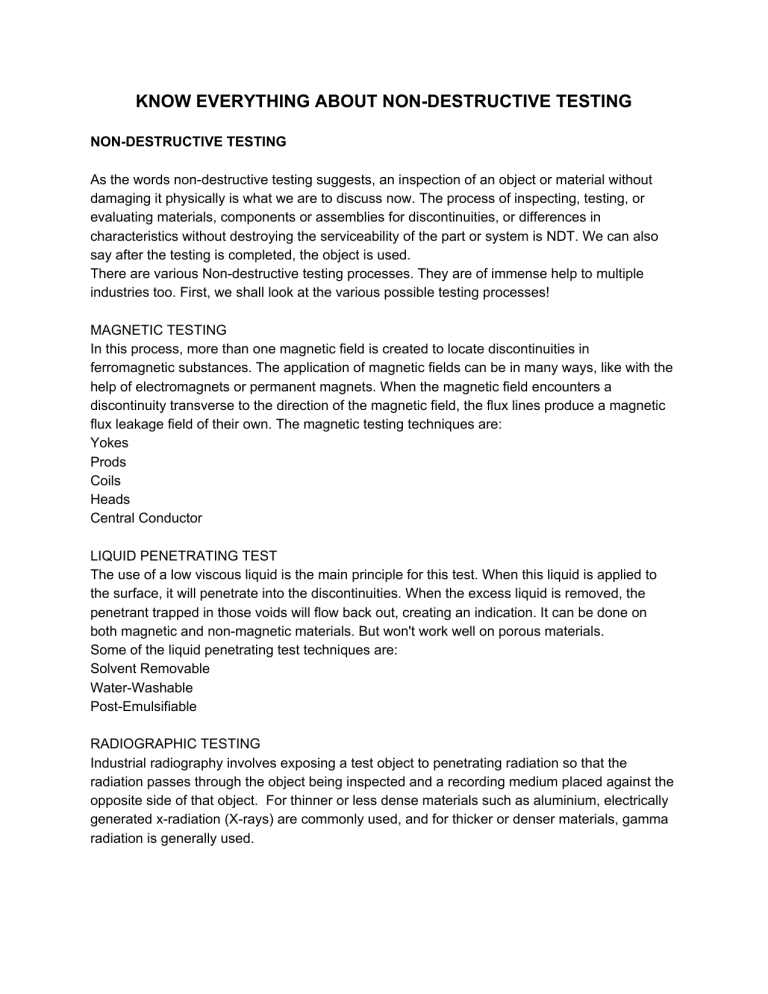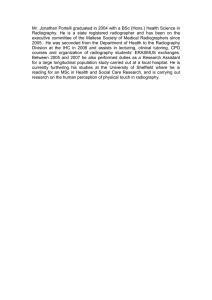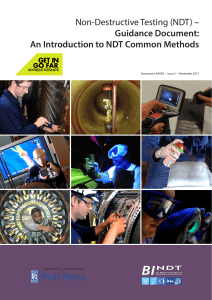
KNOW EVERYTHING ABOUT NON-DESTRUCTIVE TESTING NON-DESTRUCTIVE TESTING As the words non-destructive testing suggests, an inspection of an object or material without damaging it physically is what we are to discuss now. The process of inspecting, testing, or evaluating materials, components or assemblies for discontinuities, or differences in characteristics without destroying the serviceability of the part or system is NDT. We can also say after the testing is completed, the object is used. There are various Non-destructive testing processes. They are of immense help to multiple industries too. First, we shall look at the various possible testing processes! MAGNETIC TESTING In this process, more than one magnetic field is created to locate discontinuities in ferromagnetic substances. The application of magnetic fields can be in many ways, like with the help of electromagnets or permanent magnets. When the magnetic field encounters a discontinuity transverse to the direction of the magnetic field, the flux lines produce a magnetic flux leakage field of their own. The magnetic testing techniques are: Yokes Prods Coils Heads Central Conductor LIQUID PENETRATING TEST The use of a low viscous liquid is the main principle for this test. When this liquid is applied to the surface, it will penetrate into the discontinuities. When the excess liquid is removed, the penetrant trapped in those voids will flow back out, creating an indication. It can be done on both magnetic and non-magnetic materials. But won't work well on porous materials. Some of the liquid penetrating test techniques are: Solvent Removable Water-Washable Post-Emulsifiable RADIOGRAPHIC TESTING Industrial radiography involves exposing a test object to penetrating radiation so that the radiation passes through the object being inspected and a recording medium placed against the opposite side of that object. For thinner or less dense materials such as aluminium, electrically generated x-radiation (X-rays) are commonly used, and for thicker or denser materials, gamma radiation is generally used. The radiographic techniques are: Film Radiography Computed Radiography Computed Tomography Digital Radiography ULTRASONIC TESTING High-frequency sound waves are sent through the material being tested. If there is any part with different acoustic impedance, then some of the sent sound waves will return back as signals. Ultrasound will not travel through the air, a liquid or gel called "couplant" is used between the face of the transducer and the surface of the part to allow the sound to be transmitted into the part. The Ultrasonic testing techniques are: Straight Beam Angle Beam Immersion testing Through transmission Phased array Time of flight diffraction ELECTROMAGNETIC TESTING A general test category. While magnetic particle testing is also an electromagnetic test, due to its widespread use, it is considered a stand-alone test method instead as than an electromagnetic testing technique. The electromagnetic testing techniques are: Eddy Current testing Alternating current field measurement Remote field testing VISUAL TESTING The most commonly used testing method in the industry. It involves direct visual observation of the surface. VT inspections may be by Direct Viewing, using line-of-sight vision, or may be enhanced with the use of optical instruments such as magnifying glasses, mirrors, borescopes, charge-coupled devices (CCDs) and computer-assisted viewing systems (Remote Viewing). LASER TESTING METHODS: We all know laser. The Light Amplification by Stimulated Emission of Radiation is a definition in itself. The laser testing techniques are: Holographic testing Laser Profilometry Laser Shearography NEUTRON RADIOGRAPHIC TESTING: Neutron radiography uses an intense beam of low energy neutrons as a penetrating medium rather than the gamma- or x-radiation used in conventional radiography. Generated by linear accelerators, betatrons and other sources, neutrons penetrate most metallic materials, rendering them transparent, but are attenuated by most organic materials (including water, due to its high hydrogen content) which allows those materials to be seen within the component being inspected. When used with conventional radiography, both the structural and internal components of a test piece can be viewed. VIBRATIONAL ANALYSIS: Vibration analysis refers to the process of monitoring the vibration signatures specific to a piece of rotating machine and analysing that information to determine the condition of the equipment. Three types of sensors are commonly used: displacement sensors, velocity sensors and accelerometers. Displacement sensors use eddy current to detect vertical and horizontal motion and are well suited to detect shaft motion and changes in clearance tolerances. Basic velocity sensors use a spring-mounted magnet that moves through a coil of wire, with the outer case of the sensor attached to the part being inspected. The coil of wire moves through the magnetic field, generating an electrical signal that is sent back to a receiver and recorded for analysis. Newer model vibration sensors use time-of-flight technology and improved analysis software. The above are only some of the testing methods and Growth of NDT in recent years. Now let us go through the list of industries that require the help of NDT companies: Aerospace Automotive Medical Consumer Commercial Construction Marine Military There are many more industries that use the non-destructive methods of testing to manufacture and learn the behaviour of various materials to determine their applications. Technology that does not affect its future usefulness. NDT can be used without destroying or damaging a product or material. As it allows inspection without interfering with a product's final use, NDT provides an excellent balance of quality control and cost-effectiveness.



